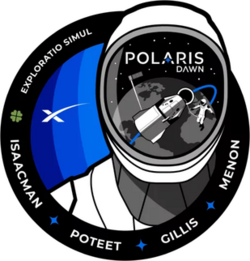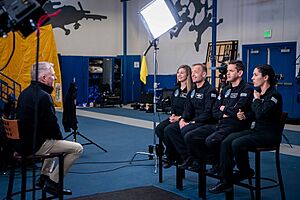Polaris Dawn facts for kids
 |
|
| Mission type | Private spaceflight |
|---|---|
| Operator | SpaceX |
| Mission duration | 4 days, 22 hours and 13 minutes |
| Orbits completed | 75 |
| Spacecraft properties | |
| Spacecraft | Crew Dragon C207 Resilience |
| Spacecraft type | Crew Dragon |
| Crew | |
| Crew size | 4 |
| Members | |
| EVAs | 1 |
| EVA duration | 26 minutes |
| Start of mission | |
| Launch date | 10 September 2024, 09:23:49 UTC (5:23:49 am EDT) |
| Rocket | Falcon 9 Block 5 (B1083.4) |
| Launch site | Kennedy, LC‑39A |
| End of mission | |
| Recovered by | MV Shannon |
| Landing date | 15 September 2024, 07:37:10 UTC (3:37:10 am EDT) |
| Landing site | Gulf of Mexico near Dry Tortugas (25°06′N 83°00′W / 25.1°N 83.0°W) |
| Orbital parameters | |
| Perigee | 190–192 km (118–119 mi) |
| Apogee |
|
| Inclination | 51.7° |
| Period | 106 minutes |
 Mission Patch  From left: Isaacman, Menon, Gillis and Poteet |
|
Polaris Dawn was a special space mission. It was a private trip to space, not run by a government agency. SpaceX operated it for Jared Isaacman, who also paid for it. This was the first of three missions in something called the Polaris program.
The mission launched on September 10, 2024. Isaacman and his three crewmates flew in a Crew Dragon spacecraft. They traveled in an elliptic orbit that took them 1,400 kilometers (870 miles) away from Earth. This was the farthest anyone had been from Earth since NASA's Apollo program in the 1970s.
The crew traveled through parts of the Van Allen radiation belt. This was to study how space radiation affects the human body. Jared Isaacman funded the mission, spending about $200 million. Later in the mission, the crew performed the first ever commercial spacewalk. This was also the first spacewalk from a Dragon spacecraft.
The Polaris Dawn mission achieved several other important things. Anna Menon and Sarah Gillis flew farther from Earth than any women before them. Gillis, at 30 years old, became the youngest person to ever do a spacewalk. During the spacewalk, a new record was set. Four people were exposed to the vacuum of space at the same time.
Contents
Mission History
The Polaris program was announced by Jared Isaacman in February 2022. This was five months after his first all-private astronaut mission, Inspiration4. That mission was also supported by Isaacman.
Developing new technologies was a key part of the Polaris program. This included special spacesuits for spacewalks. It also involved laser communication links between the Dragon spacecraft and the Starlink satellites. They also had to find a way to do spacewalks without an airlock on the Dragon capsule.
The mission was first planned for late 2022. However, it faced delays. These delays were due to designing the spacewalk suits. There were also technical problems with testing the laser communication links. The launch date kept getting pushed back. It moved from March 2023 to mid-2023, then to April 2024. Finally, it was set for July 2024.
The mission was delayed again after a problem with a Falcon 9 rocket on July 12, 2024. SpaceX fixed the issue. Polaris Dawn was then scheduled for "late summer" after the SpaceX Crew-9 mission. The launch date was pushed back several times. This was mostly due to bad weather at the landing site. Polaris Dawn finally launched on September 10, 2024.
The Dragon capsule, named Resilience, had some important changes. The inside of the capsule was modified. Extra nitrogen and oxygen tanks were added. The docking port was replaced with a special hatch called the "skywalker". This hatch has mechanical supports. The front hatch was also made motorized.
The Resilience capsule arrived at Kennedy Space Center Launch Complex 39A on August 21. It was then attached to the Falcon 9 rocket. The rocket was moved to the launch pad on August 24. The crew practiced the launch, and the rocket engines were tested on August 25. After more delays, Polaris Dawn successfully launched on September 10, 2024.
Mission Details
Space Technology
SpaceX designed special suits for the spacewalks on this mission. These EVA (Extravehicular Activity) suits were based on the IVA (Intravehicular Activity) suits. IVA suits are usually worn during launch and landing. The new EVA suits were made to keep astronauts safe in space. They also had to be comfortable and flexible for launch and landing. This meant the crew didn't need two different types of suits.
The suits were made from flame-resistant, stretchy fabric. They had soft joints for easy movement. The boots were made from the same heat-resistant material used on other parts of the Falcon 9 rocket. Compared to the IVA suits, these new suits had better temperature control. The helmet also had special heat insulation and an anti-fog treatment. A heads-up display was added to the helmet. This showed important information about the suit in real-time during the spacewalk. An umbilical cord provided life support for these suits. This is similar to early Gemini suits. It's different from the self-contained suits used on the ISS.
This mission set a new record. It had the most people (four) in the vacuum of space at once. The previous record was three people, set during Apollo 9. Because of the special way the cabin was depressurized, the crew studied how it affected their bodies. They looked at things like decompression sickness.
To make sure their procedures were safe, SpaceX tested the Resilience capsule. They put it through many cycles of depressurizing and repressurizing in a large vacuum chamber. The crew also spent two days in a chamber at the Johnson Space Center. This was to practice their breathing before the spacewalk. They also tested their EVA suits in a full vacuum.
The mission also included the first crewed test of Dragon's laser communication system. This system uses Starlink satellites. SpaceX hopes this technology will make communication faster. It could also send more data for human spaceflight.
Key Events
Within an hour after launch, the crew began a special breathing process. This was to reduce nitrogen in their bodies. It helped prevent decompression sickness during the planned spacewalk. Over three days, the cabin pressure slowly went down. At the same time, oxygen levels went up.
During their first hour in space, the crew carefully checked the Dragon capsule. They looked for any damage from the launch. After that, the Draco thrusters fired. This pushed them to the highest point of their mission. They reached 1,400 kilometers (870 miles) away from Earth. This was the highest orbit ever flown by a crewed spacecraft. It broke the record set by Gemini 11. It was also the farthest anyone had been from Earth since the 1972 Apollo 17 mission. Since those earlier missions had only male crews, Anna Menon and Sarah Gillis broke a record. They flew farther from Earth than any women before them.
On the second day of the flight, the Dragon's highest point was lowered to 730 kilometers (450 miles). This was their "cruising orbit." The crew also got their EVA suits ready and did experiments.
The third day of the flight was for the first ever extravehicular activity (EVA) on a private space mission. After a lot of preparation, all four crew members put on their EVA suits. These suits were filled with 100% oxygen. The Crew Dragon does not have a separate airlock. So, the entire capsule had to be depressurized during the spacewalk. This meant all crew members were exposed to the vacuum of space. However, only two of them partially left the spacecraft. It took about 30 minutes to depressurize the capsule. Jared Isaacman went first, spending almost eight minutes outside. Sarah Gillis went next, spending over seven minutes outside. The entire spacewalk, from opening to closing the hatch, took about 26 minutes. During the spacewalk, Isaacman and Gillis tested how well they could move in their suits. They tried controlling their hands and bodies. They also used a foot restraint. Only their lower legs remained inside the spacecraft. Gillis, at 30 years old, became the youngest person to ever do a spacewalk.
The Crew

| Position | Astronaut | |
|---|---|---|
| Commander | Jared Isaacman Second spaceflight |
|
| Pilot | Scott Poteet First spaceflight |
|
| Mission specialist | Sarah Gillis, SpaceX First spaceflight |
|
| Mission specialist Medical officer |
Anna Menon, SpaceX First spaceflight |
|
Jared Isaacman, 41, led the mission as Commander. He was in charge of operating the spacecraft. Retired Air Force fighter pilot Scott Poteet, 50, was the spacecraft pilot. He helped Isaacman with spacecraft operations. The other two crew members were SpaceX employees Sarah Gillis, 30, and Anna Menon, 38. They were Mission Specialists.
Gillis is a senior space operations engineer at SpaceX. She leads training for private space missions. She joined Isaacman on the spacewalk. Menon is a lead space operations engineer and mission director for SpaceX. She also served as the medical officer for the mission. She has six years of experience as a biomedical flight controller at NASA. There, she oversaw International Space Station operations, including several spacewalks.
Launch Details
SpaceX wanted to reduce the risk of hitting small space debris. So, mission controllers had a flexible launch window for Polaris Dawn. This allowed them to choose a time with the least amount of debris in the planned orbit. The Dragon capsule was first placed in an elliptical orbit. Its highest point was 1,200 kilometers (750 miles). It passed through the South Atlantic Anomaly at a low altitude of 190 kilometers (120 miles).
This part of the orbit exposed the crew to a lot of radiation. It was like three months on the International Space Station in just a few passes. This allowed for important research. They studied the health effects of space radiation and spaceflight on the human body.
Polaris Dawn launched from Kennedy Space Center Launch Complex 39A. It used a Falcon 9 Block 5 rocket. The first launch attempt on August 27, 2024, was stopped. This was due to a helium leak on the ground. The second launch attempt on August 28 was also stopped. The weather forecast for the landing area five days later was bad. The mission does not go to the International Space Station. It also has limited supplies. So, the capsule must be able to land as planned. This means good weather conditions are needed for landing. The launch was delayed again because of bad weather. This affected both launch and return conditions.
SpaceX aimed for a launch no earlier than September 10. The weather conditions were only 40% favorable for both liftoff and splashdown. Polaris Dawn successfully launched on September 10, 2024. The launch time was 09:23:49 UTC. This was 5:23:49 am local time at the launch site.
Launch Attempts Summary
Note: times are local to the launch site (Eastern Daylight Time).
| Attempt | Planned | Result | Turnaround | Reason | Decision point | Weather go (%) | Notes |
|---|---|---|---|---|---|---|---|
| 1 | 27 Aug 2024, 3:38:00 am | Scrubbed | — | Technical | 26 Aug 2024, 7:17 pm (T−08:21:00) | 80 | Ground-side helium leak. |
| 2 | 28 Aug 2024, 3:38:00 am | Scrubbed | 1 day, 0 hours, 0 minutes | Weather | 27 Aug 2024, 10:11 pm (T−05:27:00) | 85 | Poor predicted weather during the recovery period. |
| 3 | 10 Sep 2024, 5:23:49 am | Success | 13 days, 1 hour, 46 minutes | 40 | Launched initially scheduled for 3:38 am, delayed to second opportunity for better weather. |
See also
 In Spanish: Polaris Dawn para niños
In Spanish: Polaris Dawn para niños
- Inspiration4
- Timeline of private spaceflightid:Polaris Dawn


